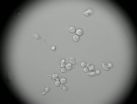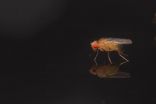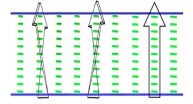(Press-News.org) VIDEO:
This video shows treatment with OTS964 induced cytokinetic defect with inter-cellular bridges that eventually led to cell apoptosis. Cell pictures were taken every 10 min.
Click here for more information.
A new drug, known as OTS964, can eradicate aggressive human lung cancers transplanted into mice, according to a report in Science Translational Medicine. The drug, given as a pill or by injection, inhibits the action of a protein that is overproduced by several tumor types, including lung and breast, but is rarely expressed in healthy adult tissues. Without this protein, cancer cells fail to complete the cell-division process and die.
When taken by mouth, the drug was well tolerated with limited toxicity. An intravenous form, delivered within a liposome, was just as effective with fewer side effects. Both approaches—described in the October 22, 2014 issue of STM—led to complete regression of transplanted tumors.
"We identified the molecular target for this drug ten years ago, but it took us nearly a decade to find an effective way to inhibit it," said study author Yusuke Nakamura, MD, PhD, professor of medicine at the University of Chicago and deputy director of the University's Center for Personalized Therapeutics. "We initially screened 300,000 compounds and then synthesized more than 1,000 of them, and found a few that were likely to work in humans. We focused on the most effective. We think we now have something very promising."
OTS964 targets TOPK (T – lymphokine-activated killer cell – originated protein kinase), a protein that is produced by a wide range of human cancers and is believed to promote tumor growth. High TOPK expression correlates with poor prognosis in patients with breast and lung cancer.
Initial studies of the drug, and a precursor called OTS514, found they were effective in killing cancer cells. But they could disrupt the production of new red and white blood cells, causing hematopoietic toxicity such as mild anemia and increasing the risk of infection. At the same time, the drugs increased the production of platelets, which help in blood clotting.
When the researchers encapsulated the drugs in liposomes—microscopic bubbles similar to a cell membrane, commonly used to transport drugs within the body—the drug no longer caused this decrease in red and white blood cells. This approach "completely eliminated the hematopoietic toxicity," the researchers wrote.
They tested OTS964 alone and in liposomes in mice with a highly aggressive human lung tumor known as LU-99. They allowed the tumors to grow to 150 cubic millimeters—about the size of a raisin—and then administered the drug intravenously to six mice, twice a week for three weeks. The tumors shrank rapidly and continued to shrink even after treatment stopped. In five of the six mice, the tumors completely disappeared—three within 25 days of the first treatment and two within 29 days. Mice that received the liposome-coated drug had no detectable toxicity.
The drug also proved effective when taken in larger doses by mouth. Six mice with LU-99 lung tumors were fed 100 milligrams per kilogram of OTS964 every day for two weeks. Again, continuous tumor shrinkage was observed after the final dose of the drug. In all six mice the tumors completely regressed. All of the mice had low white-blood-cell counts after treatment, but they recovered within two weeks.
Although this was a small study, the outcome was dramatic. Seeing these results was a "quite exciting moment," said Nakamura, who stepped down from his role as Director in the Japanese Government's Office of Medical Innovation to join the faculty at the University of Chicago in April 2012. "It is rare to see complete regression of tumors in a mouse model," he said. "Many drugs can repress the growth, but it is uncommon to see them eradicated. This has rarely been reported."
Similar studies of the drug's effects on tumor cells growing outside the body enabled the researchers to videotape the process as the cancer cells died. TOPK appears to play a central role late in cytokinesis, the final stage in cell division. Dividing cancer cells would begin to separate into two new cells, but were unable to fully disconnect, retaining an intercellular bridge.
"Without TOPK the cells can't seem to divide; they can't make the break," Nakamura said. "They can't complete the process. Instead they remain tethered by a tiny bridge. When that finally breaks apart, they can't close the membrane. Everything within the cells spills out, they suffer and then die."
TOPK may provide a good drug target for several types of cancer. This study involved primarily lung cancers, but the gene is frequently upregulated in breast, brain, liver, bladder and other solid tumors as well as certain types of leukemia. The researchers are working with oncologists at the University to begin a phase-1 clinical trial as soon as the fall of 2015.
INFORMATION:
Funding for the study was provided by the New Energy and Industrial Technology Development Organization (NEDO) of Japan and OncoTherapy Science Inc. (OTS) of Kawasaki, Kanagawa, Japan, which produces OTS964. OTS was founded in 2001 to develop anti-cancer medicines based on research targeting oncogenes and proteins by Nakamura.
Additional authors include Jae-Hyun Park and Houda Alachkar of the University of Chicago; and Yo Matsuo, Takashi Miyamoto, Shinji Yamamoto and Shoji Hisada of OncoTherapy Science Inc. Nakamura and Park are advisors to OTS and Nakamura is a stockholder.
Males of great bustard consume small doses of poison with a dual purpose: to eliminate intern parasites and, especially, to look healthier and stronger before females, allowing them to achieve a greater reproductive success. A team of researchers from the Spanish National Research Council has now suggested for the first time that this function of self-medication could be a mechanism of sexual selection. The study results are published in the PLOS ONE journal.
Juan Carlos Alonso, who led the project, CSIC researcher at the Department of Evolutive Ecology of the Spanish ...
A new study conducted by University of North Carolina School of Medicine researchers provides the first known evidence of how a similar acoustic characteristic in the cry sounds of human infants and rat pups may be used to detect the harmful effects of prenatal cocaine exposure on nervous system development.
"These findings are important because studies of prenatal drug exposure in humans are always limited by not knowing if infant nervous system damage was due to the effects of a specific drug, such as cocaine, or the effects of other associated factors, such as maternal ...
Bright colours appear on a fruit fly's transparent wings against a dark background as a result of light refraction. Researchers from Lund University in Sweden have now demonstrated that females choose a mate based on the males' hidden wing colours.
"Our experiment shows that this newly-discovered trait is important in female choice in fruit flies, and is the first evidence that wing interference patterns have a biological signalling function between the sexes during sexual selection", said Jessica Abbott, a biologist at Lund University.
The extremely thin wings of the ...
Following the study of a hospital that logged more than 2.5 million patient monitoring alarms in just one month, researchers at UC San Francisco have, for the first time, comprehensively defined the detailed causes as well as potential solutions for the widespread issue of alarm fatigue in hospitals.
Their study is in the Oct. 22 issue of PLOS ONE and available online.
The issue of alarm fatigue has become so significant that The Joint Commission, a national organization that accredits hospitals, named it a National Patient Safety Goal. This goal requires hospitals ...
WASHINGTON, Oct. 22, 2014—At first glance, the static, greyscale display created by a group of researchers from the Hong Kong University of Science and Technology, China might not catch the eye of a thoughtful consumer in a market saturated with flashy, colorful electronics. But a closer look at the specs could change that: the ultra-thin LCD screen described today in a paper in The Optical Society's (OSA) journal Optics Letters is capable of holding three-dimensional images without a power source, making it a compact, energy-efficient way to display visual information.
Liquid ...
Tropical Depression Nine formed over the western Bay of Campeche, Gulf of Mexico and is forecast to make a quick landfall on Mexico's Yucatan Peninsula. NOAA's GOES-East Satellite captured the birth of the depression.
NOAA's GOES-East Satellite captured an image of the birth of Tropical Depression 9 on Oct. 22 at 1600 UTC (12 p.m. EDT) in the western Bay of Campeche. The clouds associated with the depression stretched over the Yucatan Peninsula and into the western Caribbean Sea.
On Oct. 22, a Tropical Storm Warning was in effect from Celestun to Frontera, Mexico. The ...
Beta Pictoris is a young star located about 63 light-years from the Sun. It is only about 20 million years old and is surrounded by a huge disc of material — a very active young planetary system where gas and dust are produced by the evaporation of comets and the collisions of asteroids.
Flavien Kiefer (IAP/CNRS/UPMC), lead author of the new study sets the scene: "Beta Pictoris is a very exciting target! The detailed observations of its exocomets give us clues to help understand what processes occur in this kind of young planetary system."
For almost 30 years ...
Tiny soil microbes are among the world's biggest potential amplifiers of human-caused climate change, but whether microbial communities are mere slaves to their environment or influential actors in their own right is an open question. Now, research by an international team of scientists from the U.S., Sweden and Australia, led by University of Arizona scientists, shows that a single species of microbe, discovered only very recently, is an unexpected key player in climate change.
The findings, published in the journal Nature, should help scientists improve their simulations ...
CANCER RESEARCH UK and UCL scientists have discovered that the same specialised immune cells that patrol the body and spot infections also trigger the expansion of immune organs called lymph nodes, according to a study* published in Nature today (Wednesday).
The immune system defends the body from infections and can also spot and destroy cancer cells. Lymph nodes are at the heart of this response, but until now it has never been explained how they expand during disease.
The researchers – at Cancer Research UK's London Research Institute – found that when ...
Sequencing the genomes of tumor cells has revealed thousands of genetic mutations linked with cancer. However, sifting through this deluge of information to figure out which of these mutations actually drive cancer growth has proven to be a tedious, time-consuming process.
MIT researchers have now developed a new way to model the effects of these genetic mutations in mice. Their approach, based on the genome-editing technique known as CRISPR, is much faster than existing strategies, which require genetically engineering mice that carry the cancerous mutations.
"It's ...








